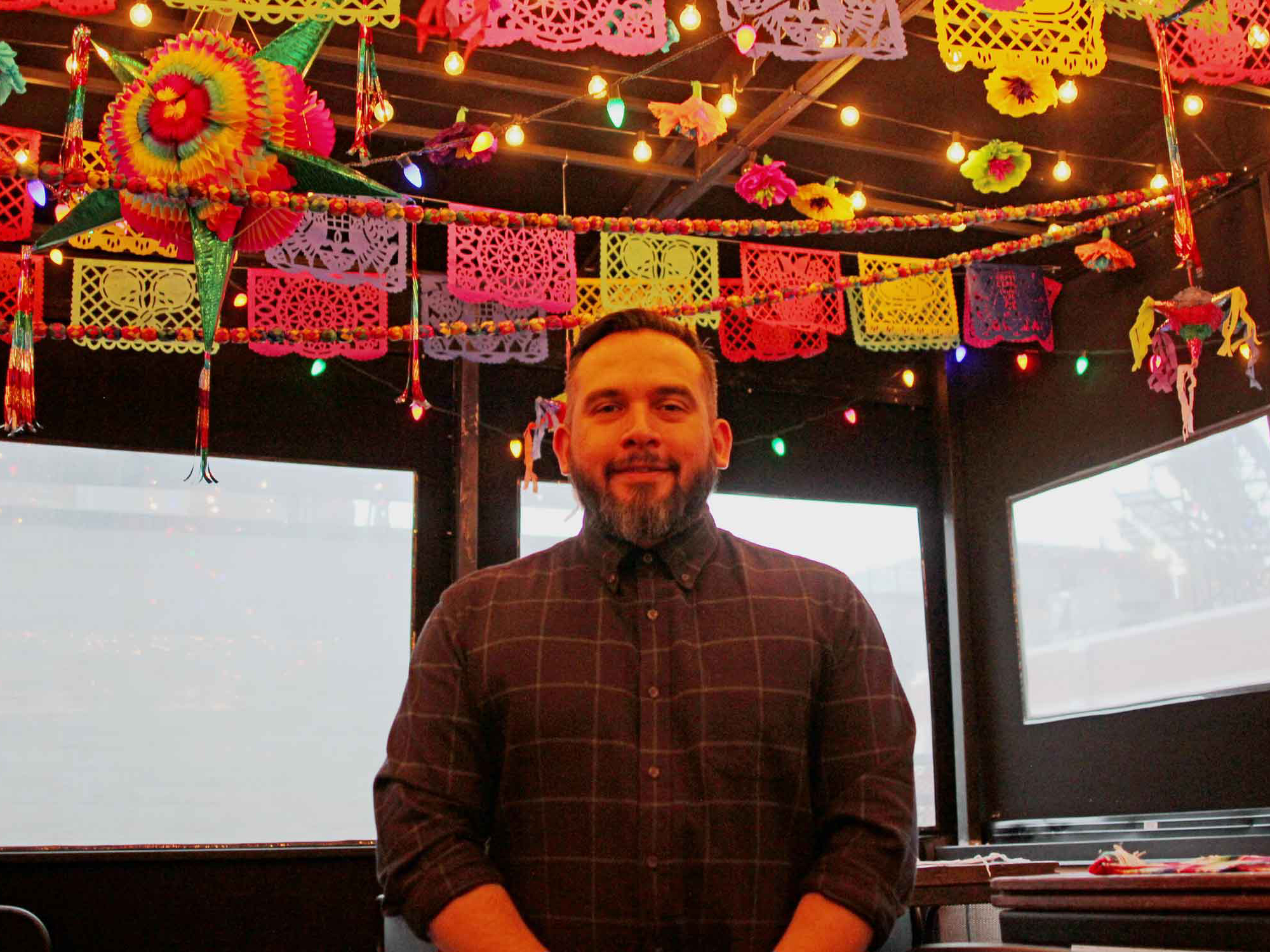“THERE’S A LOT OF INNOVATION in food in Rome, right now,” Adam Weisell says. “No, really,” he adds, when he sees I’m clearly expressing doubts.
Italy is full of modernist things, but it’s also a country where if a way of making a food wasn’t broken in 1374, don’t fix it now. Which is actually a pretty good summary of the history of the style of pizza—called “pinsa”—that Weisell makes at L’Aventino Forno Romano, in Streeterville.
“It’s a modern iteration of something that’s been done for centuries in Rome, which is the focaccia-style, airy, crispy doughs that are made with a high hydration point, and a long fermentation process,” he says.
It’s similar, for instance, to the style at Bonci, another Roman pizza in Chicago. Cutting one of his parbaked crusts in half, Weisell shows me its insides—the big bubbles and crispy structure look very much like Bonci’s. The differences are, one, that it’s a football-shaped crust, not a big sheet pizza cut with scissors.

And two, “The thing the pinsa does is add two additional types of flour—the soy flour and the rice flour,” he explains. (Bonci’s, like most pizzas, is all wheat flour.) “That lowers the gluten content while maintaining the structure, and also allows for a crispy exterior and real fragrant flavors.”
Which is what I’ll find in a few minutes when I actually try one—it’s an especially light base for the full flavor of whatever toppings you choose, but the composition of the crust also brings its own distinct flavor to it, as much like a cracker as a loaf of bread. The specific pinsa style traces back only to the early 2000s, but at the same time, “it’s a way people have made bread for centuries—it’s still a very Roman look for pizza, for flatbreads. There’s nothing subtracted from the flavor with this, but it’s a little bit lighter, you don’t feel like you need a nap when you eat a pizza.”
One thing that’s surprising is that he has a whole rack of parbaked crusts sitting there, which went into the oven earlier that day. So I ask him to walk me through the entire process, starting with making the dough. “It’s a natural starter, that we ferment for 48 hours—that gives it a little bit of a sourdough taste,” he says.
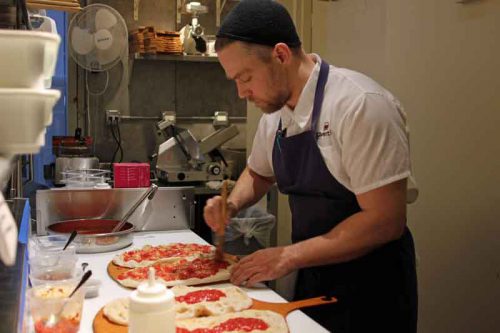
Making tomato sauce-based pizzas
Then after it’s shaped, it’s baked halfway. “It’s 100 seconds in the oven, which is just enough to establish the gluten structure in the dough. If you don’t do that, the toppings and the sauces will weigh it down, and you won’t get that structure. But it’s still quite undercooked, so then the toppings go on and it goes back in for another three, four minutes at 600 degrees, depending on what’s on top. It’s not like Neapolitan where you’re blasting it at 1000 degrees—it’s a more subtle process,” he says.
“The flavors and toppings that you find are quintessentially Italian, quintessentially Roman,” he says. “I’m trying to bring the flavors that I grew up eating to Chicago.” Besides pizza, the menu is rounded out with a variety of antipasti, salads and so on. “They’re very Italian-inspired, but they’re dishes I brought with me from every place I’ve been head chef, so they’re kind of signature dishes that followed me around. We’re really trying to be a restaurant that serves pizza, not a pizza restaurant.”
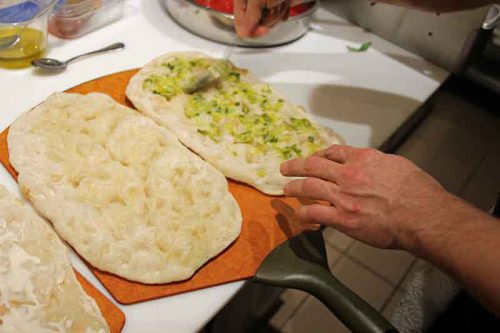
White pizzas—the one on the right is the Circo Massimo, which starts with a melted leek spread
“I have found that you cannot exactly duplicate Italian food—the ingredients are going to be different, the ovens are different, the equipment is different, and the cooks who are working with you are different,” he says. “Having said that, there’s a certain level of adherence that you have to maintain—like if I’m doing a carbonara, I’m going to use guanciale, because that’s just the way it’s done in Rome. That’s the way it tastes right, and I’ll never be the person who says, okay, let’s use bacon.”
There’s nothing subtracted from the flavor with this, but it’s a little bit lighter. You don’t feel like you need a nap when you eat a pizza.
As a result there’s nothing too out there on his menu—just high quality, naturally balanced Italian flavors. Among the red-sauced pizzas—sorry, pinsas—there’s a margherita, and a salsiccia with pork sausage, and a funghi with mushrooms; the Furio Camillo with spicy soppressata and Calabrian chili, and the Colosseo which plays off the flavors of the pasta dish bucatini all’amatriciana, with guanciale and onions. (The ones with more original names come from Roman metro stops.) “The red sauce pies are all pizzas that you would see in any pizza restaurant in Rome,” he says.
The short list of white pizzas includes the Circo Massimo (modeled on the flavors of the classic pasta dish cacio e pepe), the Bologna, which has a common (to Italians) and baffling (to Americans) set of toppings including potatoes and rosemary, and the Colli Albani, which has a whole ball of fior de latte (water buffalo mozzarella) and still returns change from a $20 bill. “The white pies, I take a little more liberty, because there’s not that many rules for that kind in Italy,” he says. There’s a well-chosen list of Italian wines, and an eclectic list of local craft beers. And if all that doesn’t spell “this is my new place” to you, it’s not for lack of trying on Weisell’s part.
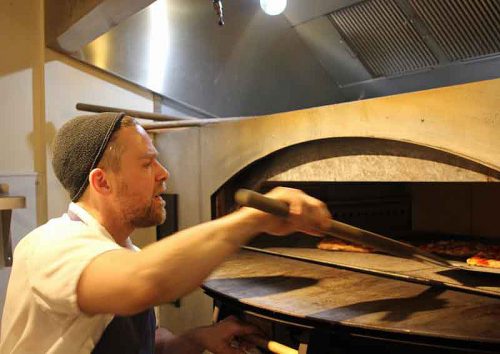
“I MOVED TO CHICAGO IN 2013, and I wanted to open my own restaurant here,” he says, when we turn to the subject of why he wanted to make this kind of pizza. “I did most of my career, eleven years, in New York and San Francisco, and I wanted a place to open a restaurant and raise my family. So I moved to Chicago.
“Once I got to know the scene here, I found out what a big deal pizza is in Chicago,” he says. “My friend Gianluca [Legrottaglie, owner of Montesacro in San Francisco] was the first one to open a pinsa restaurant in America, in 2014. And I went to eat at Montesacro, and he just got a really great reception, he was killing it over there. So I learned how to make it, I went to Rome to learn how they make it there. That is, I went back home to Rome, because I grew up there.”
This is where Weisell’s story gets particularly interesting. He was born in Indianapolis, but his father soon got a job with the UN’s food and agriculture commission, headquartered in Rome, and he moved there when he was four months old. He grew up in the expat community, and went to bilingual schools and an American high school. (When I came in, he was speaking Italian to a Spanish-speaking prep cook—similar enough to be understood.)
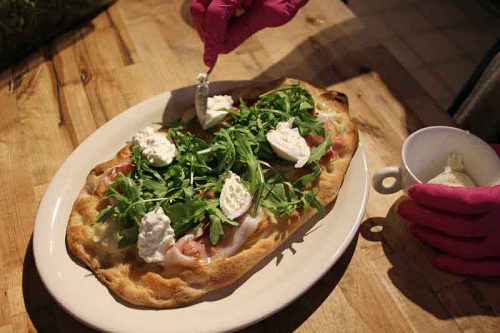
Dressing the Colli Albani, with buffalo mozzarella and arugula
“Food as culture—everybody knows it’s huge in Italy, but it’s the thing that I didn’t know until I came back to the U.S. to go to college and it was missing,” he says. “I’d always messed around in the kitchen, and when I got back to the states I was cooking more and more of my every day meals and for my friends.” We get to talking about what it’s like for your kids to grow up around your food obsession when their friends don’t, and he laughs that his daughter, now 9, “goes to these kids’ birthday parties at a bouncy-house place, and I ask how was the party? ‘Good.’ Did they have food? ‘Pizza.’ How was the pizza? ‘Crappy.'” (He says her pizza of choice, besides Dad’s, is Spacca Napoli’s.)
He dropped out of college, and started working in restaurants in upstate New York, moving to New York City in 2001 and spending four years at Mario Batali’s Roman restaurant Lupa. “From Mario Batali and Mark Ladner at Lupa, what I learned was how to capture the authenticity of flavors, but also how to break down a dish behind the line, so that you can actually execute it in large quantities—because when you work for Batali, there’s no time; there’s three guys and the doors open at 4:45 and it’s mayhem. And also, very ingredient oriented—we did a lot of shopping at the market, sourcing vegetables and meats and all that stuff, very very carefully.”
He worked for Sara Jenkins (Porchetta), who’d had a similar background to his—child of American expats in Italy: “Again, going to the Union Square Market three times a week. And very authentic—respecting the cooking traditions of Italy, without being dogmatic to the point of failure.” Then Ignacio Mattos at Il Buco—”The thing that was amazing at Il Buco was that we changed the menu daily. Every day, go into the walk-in, see what came from the market, see what had been ordered—so we’ve got these lambs, we’ve got this eggplant, mixing it around, this and that—and at the end of those twenty minutes in the walk-in, you’ve got a soup, an appetizer, a special, a couple hors d’oeuvres, four pastas, four entrees, a couple desserts.”

Margherita
Anyway, back to Chicago and pizza—and pinsa. He moved here to take a job in La Scuola, the school at Eataly, not least for its more regular hours (he might cook for a class in the evening, but he wouldn’t be scrubbing the grill at midnight). At the same time, he thought about what niche he could fill in Chicago’s bountiful pizza world.
“I thought, Chicago is such a big pizza town, [pinsa] needs to be represented,” he says. “There’s the tavern style, there’s deep dish, now there’s a smattering of New York-style places, Detroit-style, Neapolitan.
“But besides Bonci and Bar Cargo down the street, there’s nobody that does Roman-style pizza,” he says. “And that in itself is a confusing thing, because there’s four different styles of pizza you can order in Rome. So what is Roman pizza? There’s more variation than in, say, Naples, where everybody does that one thing. So this is the Roman pizza that we’re specializing in.”
The two-level space in a new building began its life as a pizza place as the original location of Robert’s Pizza in April 2016, but barely over a year later, a dispute shuttered it (Robert’s has since reopened a few blocks away). A couple of other pizza places came and went in short order, but Weisell seems unfazed by his space’s unlucky record, which he already knew—he had consulted for the place that immediately preceded his, Streeterville Pizzeria & Tap.
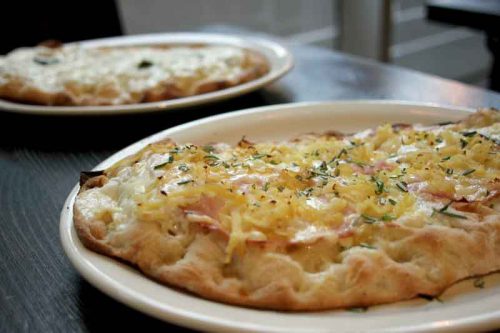
White pizzas: Bologna, with potato and rosemary, and Cinque Formaggi in rear
Nevertheless, he looked around the whole city for a space, including in Avondale where he lives with his wife and daughter, before he accepted it as his obvious choice. “I knew it had had a lot of drama, but objectively, just looking at it, it had everything I needed,” he shrugs. Naming it for the Aventine, one of the seven hills of Rome, he changed around the look of the bar and the pictures in the place, and was ready to open by November of last year. “I didn’t have the money to change many things—this is a group of friends who are doing it, there’s no big budget.”
Now he’s all in on the idea of being built-up Streeterville’s little Italian getaway for grownups. “There’s a lot of businesses, but there aren’t a lot of comfortable, everyday restaurants. There’s no real place that people will feel comfortable getting a glass of wine at the bar. I wanted to be the go-to for a lot of the people who live in these condominiums. I wanted it to be really warm, and comfortable, and inviting, and that’s what I thought was missing in this area.”
Has it worked? “We’ve had the warmest reception from the neighborhood. We have customers who are, shall I say, ultra-regulars—three, four times a week. We had some weird weeks with Thanksgiving and Christmas, but—it’s working.”
Michael Gebert is living la dolce vita as editor of Fooditor.
Latest
Join the Discussion
After you comment, click Post. If you're not already logged in you will be asked to log in or register with Disqus.






